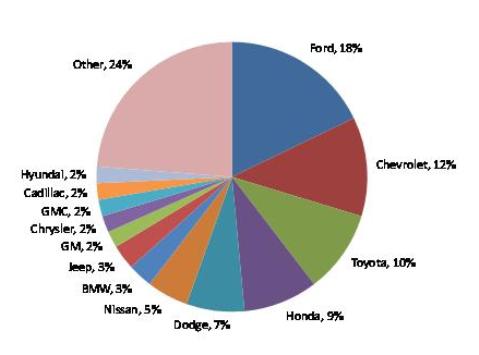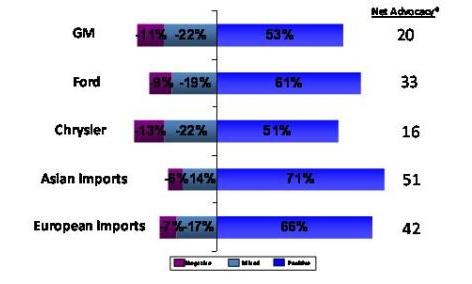Car Talk and the Value of Advertising - Ed Keller - MediaBizBloggers

The tumultuous year for the auto industry has Americans buzzing. Word of mouth about auto brands spiked a dramatic 10% from the beginning of the year to now - fueled first by the economic downturn which led to steep declines in auto sales, followed by news stories of bankruptcies and bailouts, and then a heavy dose of advertising touting Cash for Clunkers and new models.
Yet despite the summer burst of Cash for Clunkers advertising, the industry spent less on advertising in 2009 than it has in a decade, representing a $1.6 billion plunge from the prior year, according to Nielsen. The sharp cutback, particularly by GM and Chrysler, provides an interesting opportunity to assess how advertising - or the lack thereof - affects brand perceptions and buzz.
Let's start with some good news for Detroit, and a finding that will probably surprise many. The domestic auto manufacturers command a 55% majority of automotive word of mouth, with the Asian imports accounting for 35%, and European imports account for 10%. More specifically, Ford is the most talked about car brand, commanding 18% of all auto word of mouth. Chevrolet follows (at 12%) in a distant second place. Toyota finishes third (10%) followed by Honda (9%). Dodge (7%) rounds out the top five. This is according to TalkTrack, a continuous word of mouth tracking system from the Keller Fay Group that measures all word of mouth, both offline as well as online.
TalkShare™ for Automotive Brands
Source: Keller Fay’s TalkTrack®, July – August 2009
But as we all know, not all word of mouth is positive, and in the auto industry there is a wide variation, with the Asian manufacturers enjoying a substantial advantage when it comes to word of mouth quality. When we look at whether word of mouth is positive or negative, the Asian brands have a "net advocacy" score (positive WOM minus negative or mixed) of +51, a figure that is trending upward during 2009. The European name plates are strong too, although have a somewhat lower score of +42. The U.S. manufacturers' average, however, is far lower — +21.
A positive net advocacy score means that there is more positive word of mouth than negative or mixed for all three groups. But for the Asian imports, 71% of all conversations are positive; for the European imports 66% are positive; for the domestic manufacturers, it's 53%. Conversely, the negative or mixed word of mouth is higher for the domestic brands than for the Asian imports.
Among the domestics, Ford stands out as a head above the rest. Ford's net advocacy score is +33, compared to +20 for GM and +16 for Chrysler. Further, Ford's net advocacy score showed steady signs of improvement through the year to date, meaning that the quality of its "buzz" is improving and that Ford is beginning to bridge the gap between where the rest of the domestic brands stand with regard to WOM, and the Asian brands.
Polarity of Word of Mouth for Automotive Brands
Source: Keller Fay’s TalkTrack®, July – August 2009
Net advocacy = "positive" word of mouth minus "negative" or "mixed"
So what does all this mean for advertising?
During normal times, advertising is quite a large and important driver of word of mouth about all brands, including automotive, while news coverage plays a more secondary role. About 24% of all conversations about cars involve somebody referring to the content of an advertisement of some kind. But during the worst points in 2009, news shot ahead of advertising for conversations about GM and Chrysler, and narrowed the gap for most other makes.
This year, of course, news coverage was mostly negative—and hence word of mouth stimulated by news drove negative "net advocacy" scores for GM and Chrysler. Even so, word of mouth stimulated by advertising actually stayed positive for these brands. The trouble was, with advertising dramatically cut back for these brands in particular, there was less of the positive ad-inspired WOM to offset the negative news-stimulated WOM.
Several of the automakers had little choice but to go quiet with their advertising under unique conditions this year. Still, the result serves as a cautionary tale for advertisers dealing with future crisis situations. Silence equals disarmament.
Our research finds that not only does advertising, normally, drive a large share of word of mouth, but that word of mouth about brands is more productive when influenced by advertising. WOM supported by advertising is 20% more likely to include a strong recommendation to buy or try the brand, compared to all other advertising. And the most effective WOM of all is among customers of the brand who are talking about advertising.
This is not to say that advertising should continue during a crisis as if nothing has changed. Advertising should respond to changes in needs and attitudes. It should address the topics people want to know about, and are talking about. And it should do so in a tone and style that reflects current conditions. And when it does so, and does it well, advertising will get people talking—and advocating. Which is what the goal of advertising must be in today's word of mouth era.
The moral of this story: silence is not always golden, especially during times of turmoil.
Ed Keller, CEO of the Keller Fay Group, has been called "one of the most recognized names in word of mouth." The publication of Keller's book,The Influentials, has been called the "seminal moment in the development of word of mouth." Ed can be contacted at ekeller@kellerfay.com.
Read all Ed’s MediaBizBloggers commentaries at Ed Keller - MediaBizBloggers.
Follow our Twitter updates @MediaBizBlogger




